MainStage User Guide
- Welcome
-
- Overview of Edit mode
-
- Select patches and sets in the Patch List
- Copy, paste, and delete patches
- Reorder and move patches in the Patch List
- Add and rename patches
- Create a patch from several patches
-
- Overview of the Patch Settings Inspector
- Select patch settings in the Patch Library
- Set the time signature for patches
- Change the tempo when you select a patch
- Set program change and bank numbers
- Defer patch changes
- Instantly silence the previous patch
- Change patch icons
- Transpose the pitch of incoming notes for a patch
- Change the tuning for a patch
- Add text notes to a patch
-
- Overview of channel strips
- Add a channel strip
- Change a channel strip setting
- Configure channel strip components
- Show signal flow channel strips
- Hide the metronome channel strip
- Create an alias of a channel strip
- Add a patch bus
- Set channel strip pan or balance positions
- Set channel strip volume levels
- Mute and solo channel strips
- Use multiple instrument outputs
- Use external MIDI instruments
- Reorganize channel strips
- Delete channel strips
-
- Overview of the Channel Strip Inspector
- Choose channel strip settings
- Rename channel strips
- Change channel strip colors
- Change channel strip icons
- Use feedback protection with channel strips
- Set keyboard input for a software instrument channel strip
- Transpose individual software instruments
- Filter MIDI messages
- Scale channel strip velocity
- Set channel strips to ignore Hermode tuning
- Override concert- and set-level key ranges
- Add text notes to a channel strip in the Channel Strip Inspector
- Route audio via send effects
-
- Screen Control Inspector overview
- Replace parameter labels
- Choose custom colors for screen controls
- Change background or grouped screen control appearance
- Set screen controls to show the hardware value
- Set parameter change behavior for screen controls
- Set hardware matching behavior for screen controls
- Reset and compare changes to a patch
- Override concert- and set-level mappings
-
- Overview of mapping screen controls
- Map to channel strip and plug-in parameters
- Map screen controls to actions
- Map a screen control to multiple parameters
- Use screen controls to display PDF document pages
- Edit the saved value for a mapped parameter
- Set drum pads or buttons to use note velocity
- Map screen controls to all channel strips in a patch
- Undo screen control parameter mappings
- Remove screen control mappings
- Work with graphs
- Create controller transforms
- Share patches and sets between concerts
- Record the audio output of a concert
-
- Overview of concerts
- Create a concert
- Open and close concerts
- Save concerts
- How saving affects parameter values
- Clean up concerts
- Consolidate assets in a concert
- Rename the current concert
-
- Overview of the Concert Settings Inspector
- Set MIDI Routing to channel strips
- Transpose incoming note pitch for a concert
- Define the program change message source
- Send unused program changes to channel strips
- Set the time signature for a concert
- Change the tuning for a concert
- Set the pan law for a concert
- Add text notes to a concert
- Control the metronome
- Silence MIDI notes
- Mute audio output
-
- Layout mode overview
-
- Screen control parameter editing overview
- Lift and stamp screen control parameters
- Reset screen control parameters
- Common screen control parameters
- Keyboard screen control parameters
- MIDI activity screen control parameters
- Drum pad screen control parameters
- Waveform screen control parameters
- Selector screen control parameters
- Text screen control parameters
- Background screen control parameters
- How MainStage passes through MIDI messages
- Export and import layouts
- Change the aspect ratio of a layout
-
- Before performing live
- Use Perform mode
- Screen controls in performance
- Tempo changes during performance
- Tips for performing with keyboard controllers
- Tips for performing with guitars and other instruments
- Tune guitars and other instruments with the Tuner
- The Playback plug-in in performance
- Record your performances
- After the performance
- Tips for complex hardware setups
-
- Overview of keyboard shortcuts and command sets
-
- Concerts and layouts keyboard shortcuts
- Patches and sets (Edit mode) keyboard shortcuts
- Editing keyboard shortcuts
- Actions keyboard shortcuts
- Parameter mapping (Edit mode) keyboard shortcuts
- Channel strips (Edit mode) keyboard shortcuts
- Screen controls (Layout mode) keyboard shortcuts
- Perform in Full Screen keyboard shortcuts
- Window and view keyboard shortcuts
- Help and support keyboard shortcuts
-
-
- Use MIDI plug-ins
-
- Arpeggiator overview
- Arpeggiator control parameters
- Note order parameters overview
- Note order variations
- Note order inversions
- Arpeggiator pattern parameters overview
- Use Live mode
- Use Grid mode
- Arpeggiator options parameters
- Arpeggiator keyboard parameters
- Use keyboard parameters
- Assign controllers
- Modifier controls
- Note Repeater controls
- Randomizer controls
-
- Use Scripter
- Use the Script Editor
- Scripter API overview
- MIDI processing functions overview
- HandleMIDI function
- ProcessMIDI function
- GetParameter function
- SetParameter function
- ParameterChanged function
- Reset function
- JavaScript objects overview
- Use the JavaScript Event object
- Use the JavaScript TimingInfo object
- Use the Trace object
- Use the MIDI event beatPos property
- Use the JavaScript MIDI object
- Create Scripter controls
- Transposer controls
-
-
- Alchemy overview
- Alchemy interface overview
- Alchemy Name bar
- Alchemy file locations
-
- Alchemy source overview
- Source master controls
- Import browser
- Source subpage controls
- Source filter controls
- Source filter use tips
- Source elements overview
- Additive element controls
- Additive element effects
- Spectral element controls
- Spectral element effects
- Pitch correction controls
- Formant filter controls
- Granular element controls
- Sampler element controls
- VA element controls
- Wide unison mode
- Source modulations
- Morph controls
- Alchemy master voice section
- Alchemy Extended parameters
-
- Playback plug-in overview
- Add a Playback plug-in
- Playback interface
- Use the Playback waveform display
- Playback transport and function buttons
- Playback information display
- Playback Sync, Snap To, and Play From parameters
- Use the Playback group functions
- Use the Playback Action menu and File field
- Use markers with the Playback plug-in
-
- Sample Alchemy overview
- Interface overview
- Add source material
- Edit mode
- Play modes
- Source overview
- Synthesis modes
- Granular controls
- Additive effects
- Additive effect controls
- Spectral effect
- Spectral effect controls
- Filter module
- Lowpass, bandpass, and highpass filters
- Comb PM filter
- Downsampler filter
- FM filter
- Envelope generators
- Mod Matrix
- Modulation routing
- Motion mode
- Trim mode
- More menu
-
- Sculpture overview
- Sculpture interface
- Global parameters
- Amplitude envelope parameters
- Use the Waveshaper
- Filter parameters
- Output parameters
- Define MIDI controllers
- Extended parameters
-
- Studio Piano
- Copyright

Use Drum Kit Designer in MainStage
Drum Kit Designer shows a 3D representation of the drum kit for the currently loaded patch.
For all kits, you can preview the drums, edit the pitch, sustain, and volume of each drum kit piece, and exchange the kick and snare drums. When working with multi-channel kits, you can additionally exchange toms, cymbals, and hi-hat. Multi-channel kits let you turn different microphones, such as overheads or room mics, on or off.
Note: Multi-channel kits and some drums are only available after you download additional content.
Drum Kit Designer also has additional parameters for adjusting the gain of other instrument pieces, such as shaker, cowbell, and so on. See Drum Kit Designer extended parameters.
Preview a drum or percussion piece
In MainStage, click a drum or percussion piece.
The first time you click any drum or percussion piece after opening the plug-in, one or two panes open. You can exchange individual sounds in the Exchange pane to the left and can edit individual drum or percussion piece settings in the Edit pane to the right.
Adjust kit piece settings (all kits)
In MainStage, click a drum or percussion piece.
The Edit pane opens to the right.
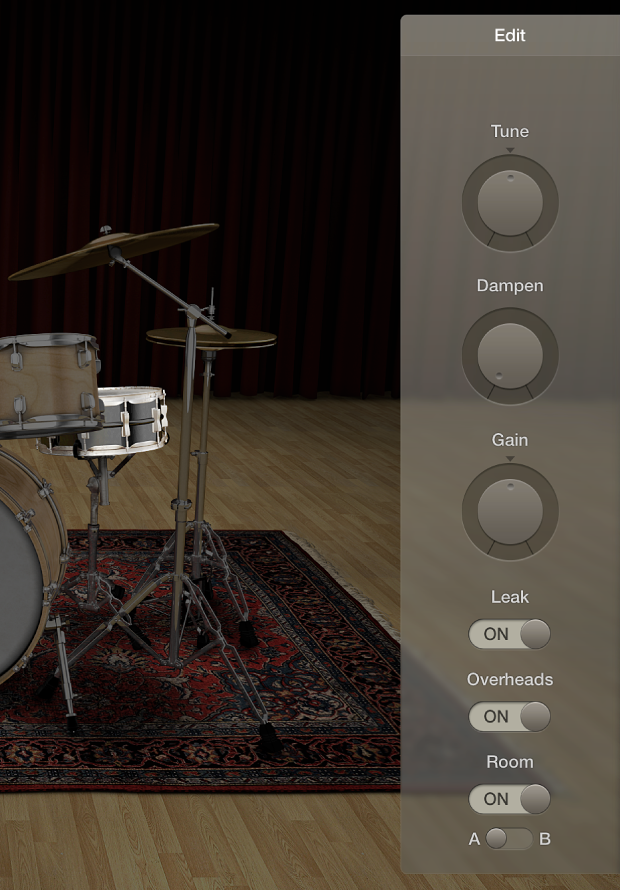
Toms: Click the tab for the tom you want to edit, or click the All tab to adjust the tone of all toms.
Cymbals: Click the tab for the crash cymbal you want to edit, or click the All tab to adjust the tone of both crash cymbals. The ride cymbal can be edited directly.
Kicks and snares: There are no tabs, so make your adjustments with the controls.
To adjust settings, do any of the following:
To adjust the pitch: Drag the Tune control vertically, or double-click the field and enter a new value.
To adjust the sustain: Drag the Dampen control vertically, or double-click the field and enter a new value.
To adjust the volume: Drag the Gain control vertically, or double-click the field and enter a new value.
To close open panes, click anywhere in the plug-in window background.
Exchange a kit piece
For all kits, you can exchange kick and snare. When working with multi-channel kits, you can additionally exchange toms, cymbals, and hi-hat.
Note: Multi-channel kits and some drums are only available after you download additional content.
In MainStage, click a drum or percussion piece.
The Exchange pane opens to the left if exchange pieces are available for that kit piece.
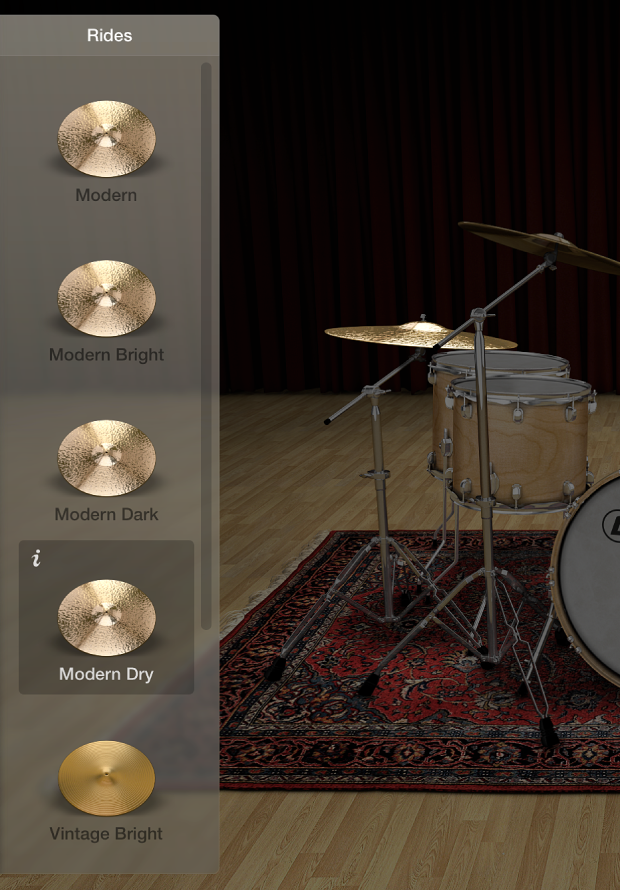
Click the Info button of a selected piece to view its description.
Click the kit piece that you want to exchange in the Exchange pane. You may need to scroll to find the piece you want to use.
The piece is exchanged and the respective drum sound is loaded.
Note: The toms and the crash cymbals can only be exchanged as a group.
To close the panes, click anywhere in the plug-in window background.
Adjust mic settings (multi-channel kits only)
In the Edit pane, do any of the following:
To include the sound in the mic of the other kit pieces: Turn on the Leak switch.
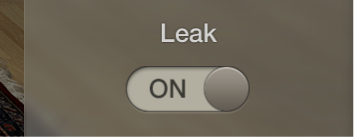
This turns microphone bleed on or off, where the sound of a kit piece is picked up by the different mics from other kit pieces.
To include the kit piece overhead mic in the sound: Turn on the Overheads switch.
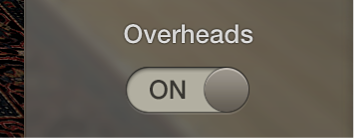
This turns the overhead mic for the selected kit piece on or off.
To choose a room emulation to use with the sound: Choose between rooms A and B. You can also turn off the room microphones.
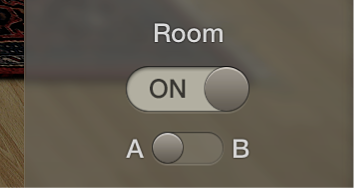
Rooms A and B determine which room mic setup is used with the kit piece.